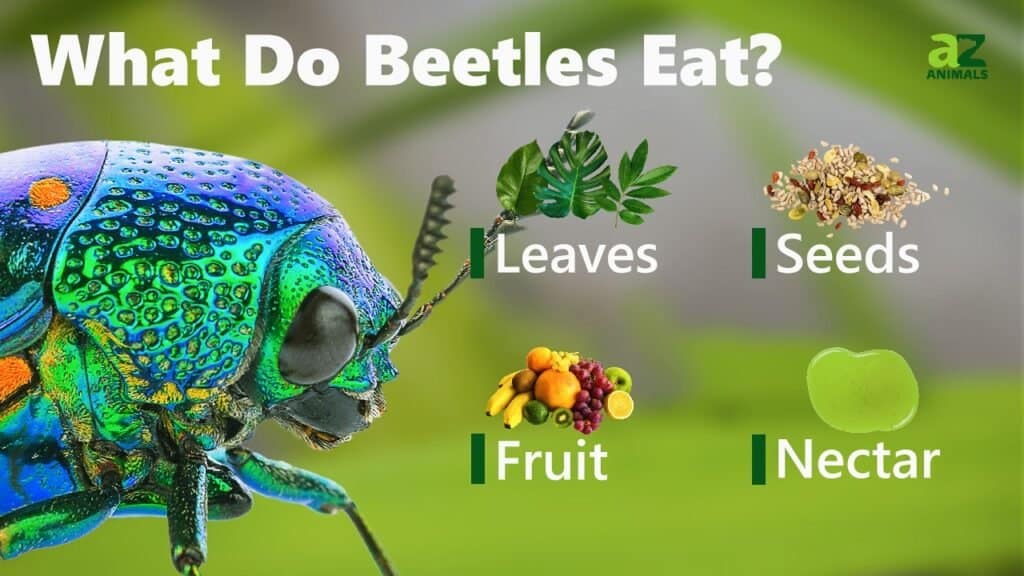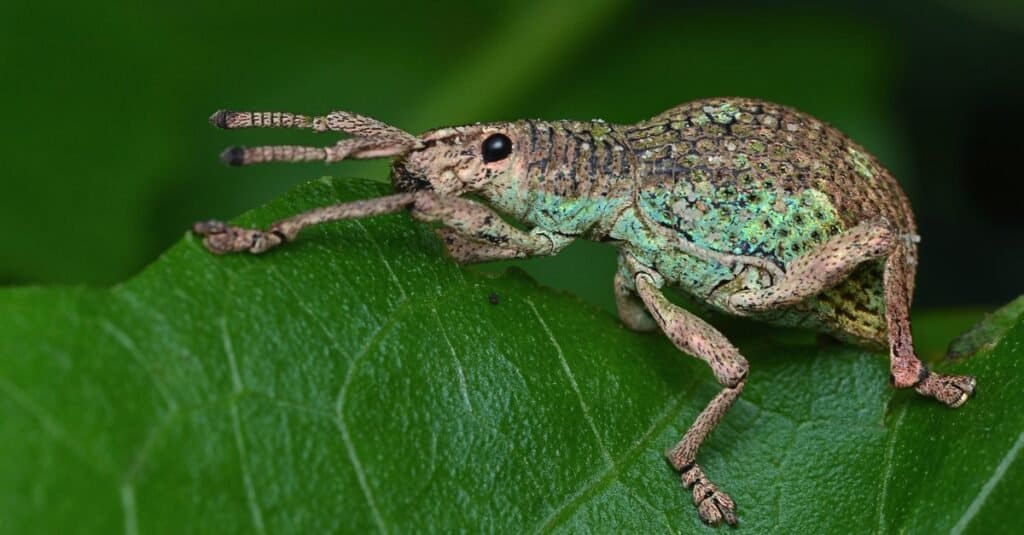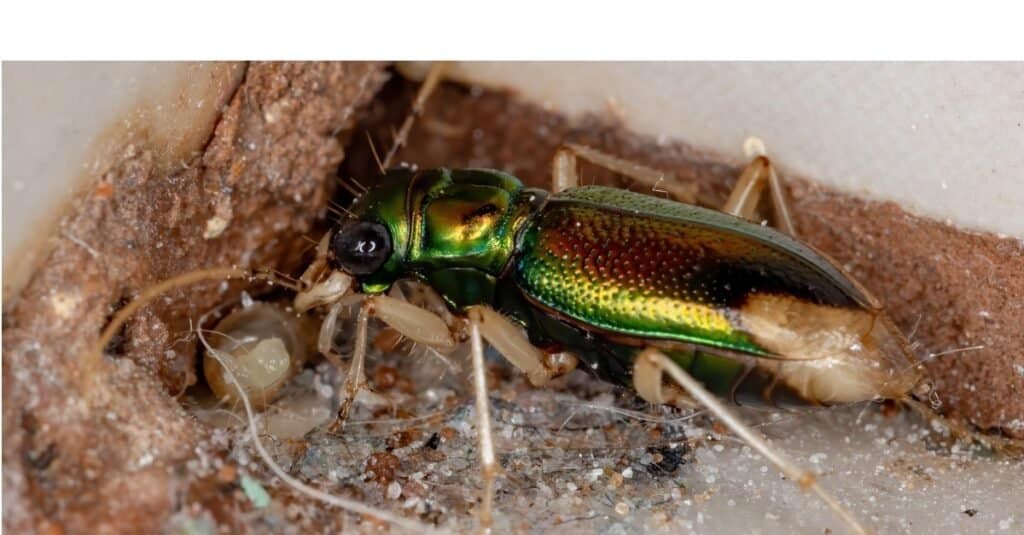What Do Beetles Eat?

A-Z-Animals.com
When you contemplate what foods beetles eat, it is tempting to say “just about everything.” Indeed, beetles do eat everything from carrion to plants to carpet fibers to dung to the roses in your garden, but not every beetle eats everything. A lot are picky when it comes to what’s on their diet.
Perhaps beetles eat such a variety of foods because there are so many of them. These robust insects have been around for at least 270 million years, are spread over 400,000 species and make up 25 percent of all animal life. They are found everywhere save the polar regions and come in many sizes, if not that many shapes. They are usually roundish, have hardened forewings that need to be raised when they fly, and with the exception of the blister beetles, chewing mouthparts. Let’s check out the diet of these insects:
What Foods Do Beetles Eat?

Leong9655/Shutterstock.com
Because beetles eat so many different kinds of food, it may be useful to list some and the things that they eat:
- Dung Rolling Beetles – Dung beetles are types of scarabs, and they’re found everywhere save Antarctica. The insects found in the Scarabaeinae family eat dung exclusively while others sometimes eat rotting fruit and leaves or mushrooms. Others are also predators that eat ants and millipedes. Beetles that eat nothing but dung get all their water and nutrients from their food source. These insects not only eat dung, but they are fond of rolling it into little balls. The female lays her egg in the center of the ball, and both parents bury it. When the grub hatches, it starts to eat the dung. One type of dung beetle navigates by the stars, but scientists don’t know how it knows to do this. Dung beetles are black, green or bronze and range in size from 0.39 to 0.70 inches.
- Carrion Clown Beetle – This little black beetle eats dead things and is partial to dead frogs and fish washed up on the banks of bodies of water. It is a tiny beetle, only between 0.18 and 0.20 inches long and has short antennae and punctures in its upper wings that makes it resemble a shoe button.
- Carpet Beetle – In all fairness, the carpet beetle doesn’t eat carpet fibers. Its grubs do. The larvae not only eat carpets, but clothing and upholstery if they are made of natural fibers such as wool or cotton. One thing that makes the larvae of this beetle so destructive is that they can remain larval for as long as three years. Ironically, the adults don’t eat, but the female can lay as many as 100 eggs.
- Boll Weevil – Unfortunately, the adults of this beetle do eat, and they eat the buds and the flowers of the cotton plant. Not only the adults but the larvae infest the plants. Native to Mexico, this insect somehow got to the southern United States by the end of the 19th century and spent much of the 20th century devastating the cotton industry. Like other weevils, who by the way eat plants from roses to chestnuts to agave to black-eyed peas, this beetle can be told by its long, curved snout. It’s not that large, about 0.24 inches long and has a grayish color.
Other things beetles like to eat include:
- Other insects, including bees, wasps, aphids, and other plant pests and their larvae
- Powdered milk, a favorite of the Pleasing Fungus Beetle
- Pollen
- Nectar
- Spiders
- Tree bark and heartwood, like the emerald ash borer larvae
- Flour
- Many types of flowers, buds, and leaves
- The wood of floors and furniture like the pine borer
- Ripe fruit
- Plant roots, including root vegetables such as carrots (larvae)
- Decaying wood
- Fungi
- Small fish
- Snails and slugs
- The larvae of Zophobas atratus, grubs of black beetles called darkling beetles, appear to thrive on styrofoam.
How Do Beetles Hunt Prey?

Beetles have a number of strategies for hunting prey. Sometimes only the larvae actually hunt, since the adult eats little or not at all. But sometimes the young and the adults enjoy the same diet. The ladybird beetle flies to the place where prey is likely to be and lays her eggs under a leaf of the plant. When the larvae hatch, the adult and the larvae both mow down the aphids, scale insects, or whatever else is infesting the plant.
Scaphinotus angusticollis is a black beetle with long legs that’s found in North America. Flightless, it hunts and eats snails. It travels over the ground looking under logs for its prey, and when it finds a snail it uses its long mouthparts to reach into the shell and eat the meat. The beetle also feasts on the easier-to-catch slug and sometimes eats fruit.
Found in Europe and Asia, the great diving beetle is a big aquatic beetle that can grow to 1.4 inches long. It lives in fresh water and creates an air supply for itself by collecting bubbles that it tucks under its wings next to its breathing pores. While underwater it hunts other aquatic insects, tadpoles, and small fish and snatches them with its powerful jaws. Males even have suction cups on their legs that let them hold on to prey as well as females.
Tiger beetles run toward their prey, stop, orient themselves then race after it while holding their antennae straight out in front of them to avoid obstacles. Tiger beetles are good fliers and can also grab prey on the wing.
What Animals Eat Beetles?

Beetles eat just about everything, and many living things eat beetles, including humans. One great delicacy in Thailand is the grub of a Hercules beetle wrapped in banana leaves, roasted then eaten with special sauce. Indeed, the grubs of many beetles are edible, including those of weevils, longhorn beetles, and Japanese beetles. Other animals that eat beetles include:
- Mammals, including raccoons, skunks, shrews, hedgehogs, moles, rodents, prosimians, foxes, and kinkajous.
- Spiders
- Other insects, including assassin bugs
- Lizards
- Birds
- Frogs
- Toads
- Snakes
Next Up: Types of Red Birds
More from A-Z Animals

A-Z-Animals.com
When you contemplate what foods beetles eat, it is tempting to say “just about everything.” Indeed, beetles do eat everything from carrion to plants to carpet fibers to dung to the roses in your garden, but not every beetle eats everything. A lot are picky when it comes to what’s on their diet.
Perhaps beetles eat such a variety of foods because there are so many of them. These robust insects have been around for at least 270 million years, are spread over 400,000 species and make up 25 percent of all animal life. They are found everywhere save the polar regions and come in many sizes, if not that many shapes. They are usually roundish, have hardened forewings that need to be raised when they fly, and with the exception of the blister beetles, chewing mouthparts. Let’s check out the diet of these insects:
What Foods Do Beetles Eat?

Leong9655/Shutterstock.com
Because beetles eat so many different kinds of food, it may be useful to list some and the things that they eat:
- Dung Rolling Beetles – Dung beetles are types of scarabs, and they’re found everywhere save Antarctica. The insects found in the Scarabaeinae family eat dung exclusively while others sometimes eat rotting fruit and leaves or mushrooms. Others are also predators that eat ants and millipedes. Beetles that eat nothing but dung get all their water and nutrients from their food source. These insects not only eat dung, but they are fond of rolling it into little balls. The female lays her egg in the center of the ball, and both parents bury it. When the grub hatches, it starts to eat the dung. One type of dung beetle navigates by the stars, but scientists don’t know how it knows to do this. Dung beetles are black, green or bronze and range in size from 0.39 to 0.70 inches.
- Carrion Clown Beetle – This little black beetle eats dead things and is partial to dead frogs and fish washed up on the banks of bodies of water. It is a tiny beetle, only between 0.18 and 0.20 inches long and has short antennae and punctures in its upper wings that makes it resemble a shoe button.
- Carpet Beetle – In all fairness, the carpet beetle doesn’t eat carpet fibers. Its grubs do. The larvae not only eat carpets, but clothing and upholstery if they are made of natural fibers such as wool or cotton. One thing that makes the larvae of this beetle so destructive is that they can remain larval for as long as three years. Ironically, the adults don’t eat, but the female can lay as many as 100 eggs.
- Boll Weevil – Unfortunately, the adults of this beetle do eat, and they eat the buds and the flowers of the cotton plant. Not only the adults but the larvae infest the plants. Native to Mexico, this insect somehow got to the southern United States by the end of the 19th century and spent much of the 20th century devastating the cotton industry. Like other weevils, who by the way eat plants from roses to chestnuts to agave to black-eyed peas, this beetle can be told by its long, curved snout. It’s not that large, about 0.24 inches long and has a grayish color.
Other things beetles like to eat include:
- Other insects, including bees, wasps, aphids, and other plant pests and their larvae
- Powdered milk, a favorite of the Pleasing Fungus Beetle
- Pollen
- Nectar
- Spiders
- Tree bark and heartwood, like the emerald ash borer larvae
- Flour
- Many types of flowers, buds, and leaves
- The wood of floors and furniture like the pine borer
- Ripe fruit
- Plant roots, including root vegetables such as carrots (larvae)
- Decaying wood
- Fungi
- Small fish
- Snails and slugs
- The larvae of Zophobas atratus, grubs of black beetles called darkling beetles, appear to thrive on styrofoam.
How Do Beetles Hunt Prey?

Beetles have a number of strategies for hunting prey. Sometimes only the larvae actually hunt, since the adult eats little or not at all. But sometimes the young and the adults enjoy the same diet. The ladybird beetle flies to the place where prey is likely to be and lays her eggs under a leaf of the plant. When the larvae hatch, the adult and the larvae both mow down the aphids, scale insects, or whatever else is infesting the plant.
Scaphinotus angusticollis is a black beetle with long legs that’s found in North America. Flightless, it hunts and eats snails. It travels over the ground looking under logs for its prey, and when it finds a snail it uses its long mouthparts to reach into the shell and eat the meat. The beetle also feasts on the easier-to-catch slug and sometimes eats fruit.
Found in Europe and Asia, the great diving beetle is a big aquatic beetle that can grow to 1.4 inches long. It lives in fresh water and creates an air supply for itself by collecting bubbles that it tucks under its wings next to its breathing pores. While underwater it hunts other aquatic insects, tadpoles, and small fish and snatches them with its powerful jaws. Males even have suction cups on their legs that let them hold on to prey as well as females.
Tiger beetles run toward their prey, stop, orient themselves then race after it while holding their antennae straight out in front of them to avoid obstacles. Tiger beetles are good fliers and can also grab prey on the wing.
What Animals Eat Beetles?

Beetles eat just about everything, and many living things eat beetles, including humans. One great delicacy in Thailand is the grub of a Hercules beetle wrapped in banana leaves, roasted then eaten with special sauce. Indeed, the grubs of many beetles are edible, including those of weevils, longhorn beetles, and Japanese beetles. Other animals that eat beetles include:
- Mammals, including raccoons, skunks, shrews, hedgehogs, moles, rodents, prosimians, foxes, and kinkajous.
- Spiders
- Other insects, including assassin bugs
- Lizards
- Birds
- Frogs
- Toads
- Snakes
Next Up: Types of Red Birds






